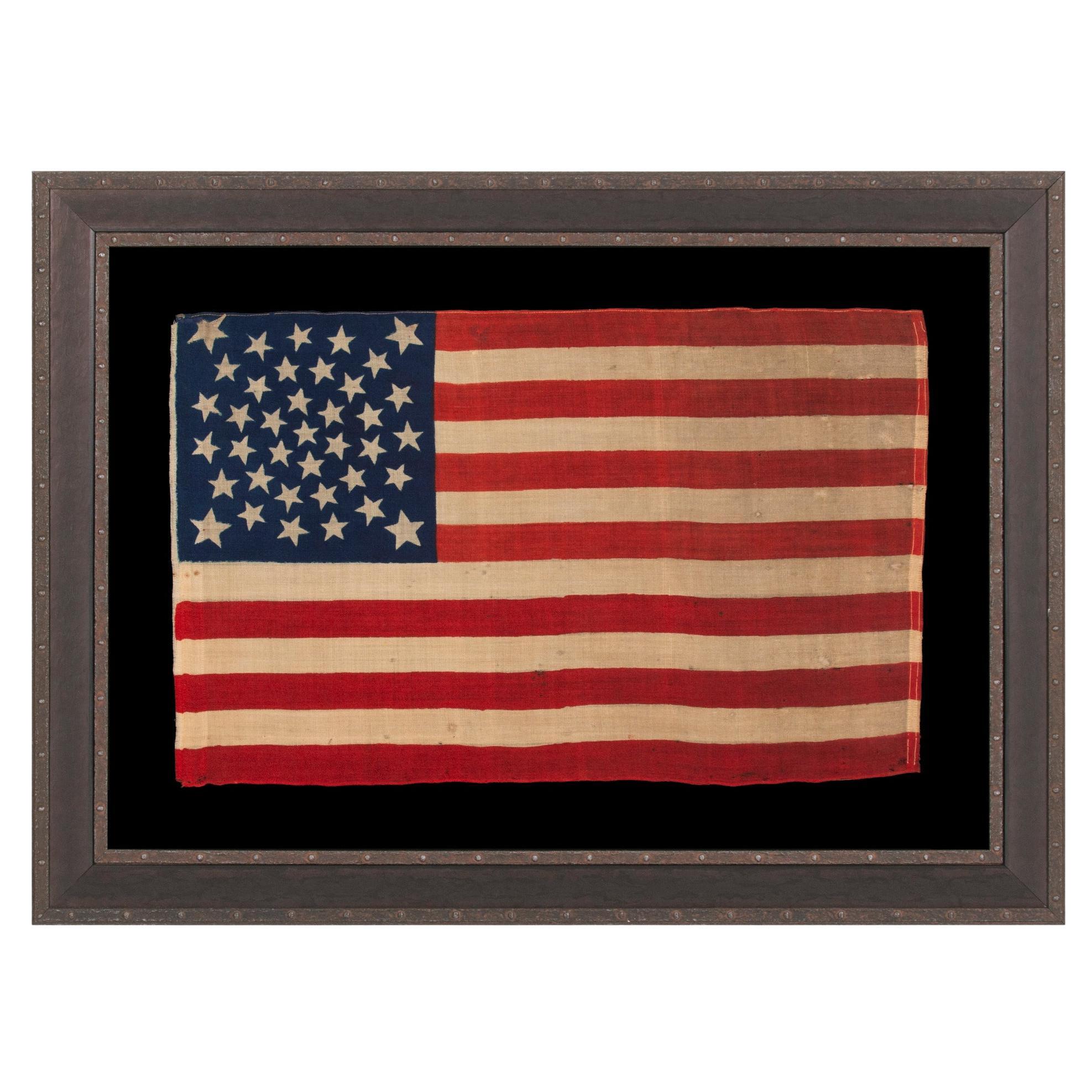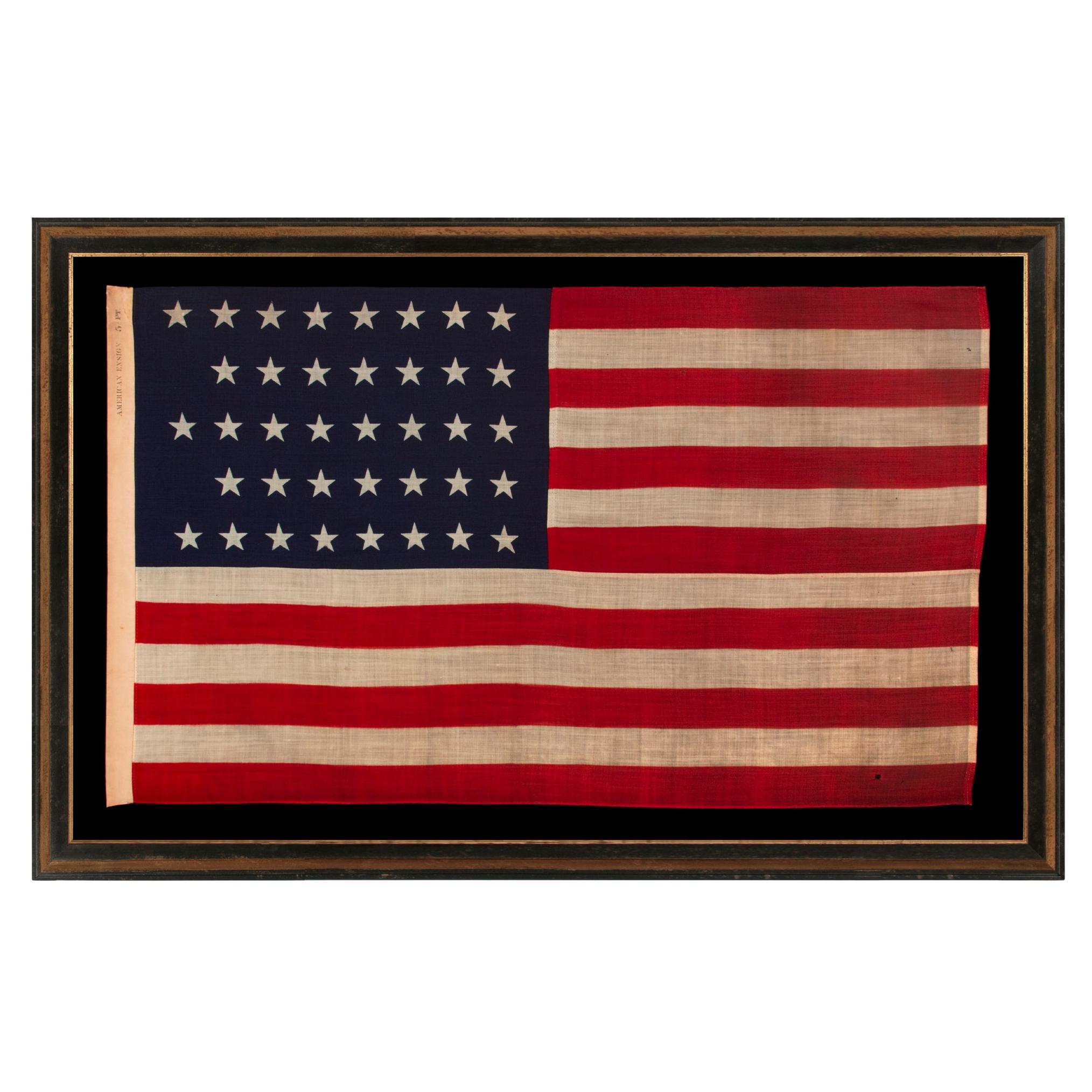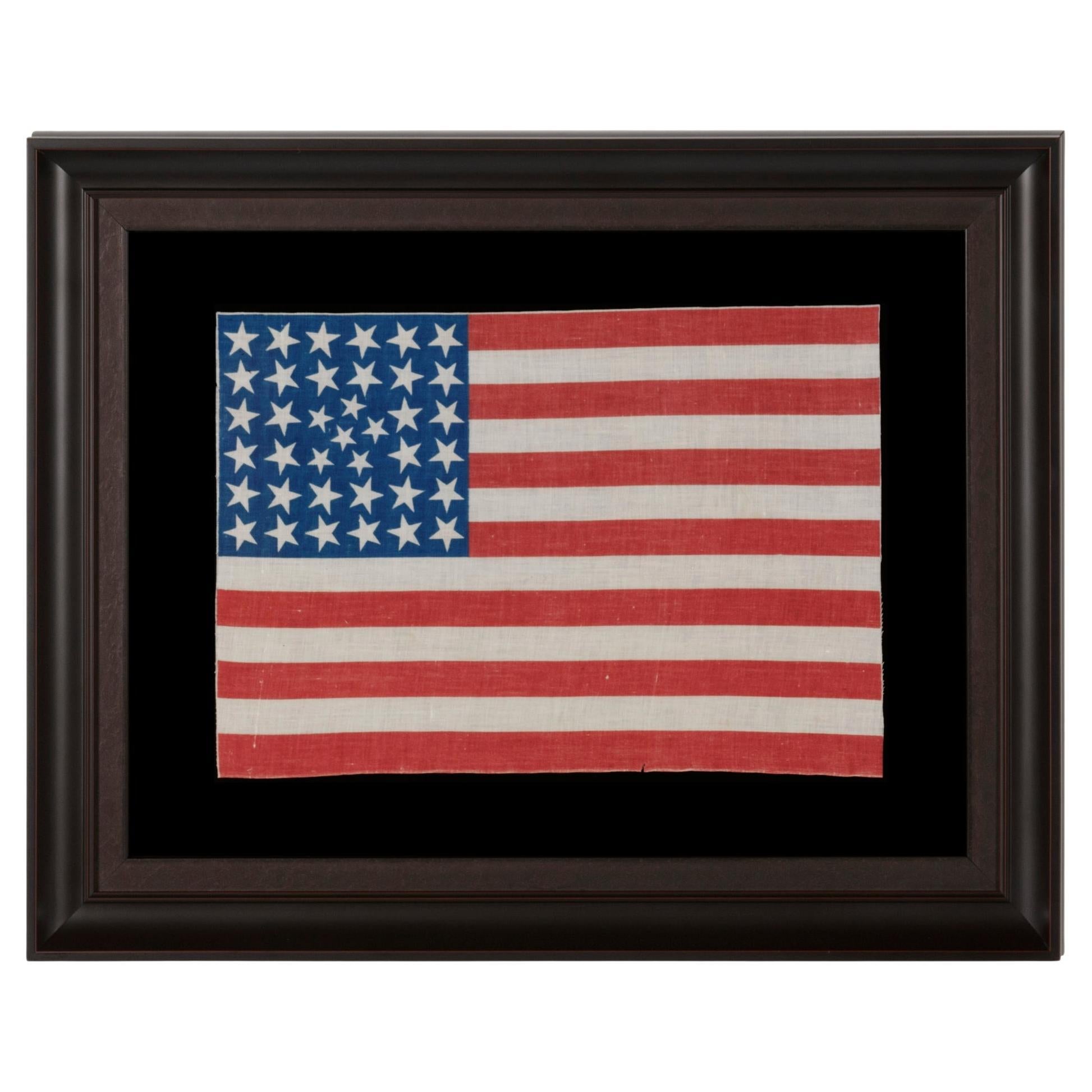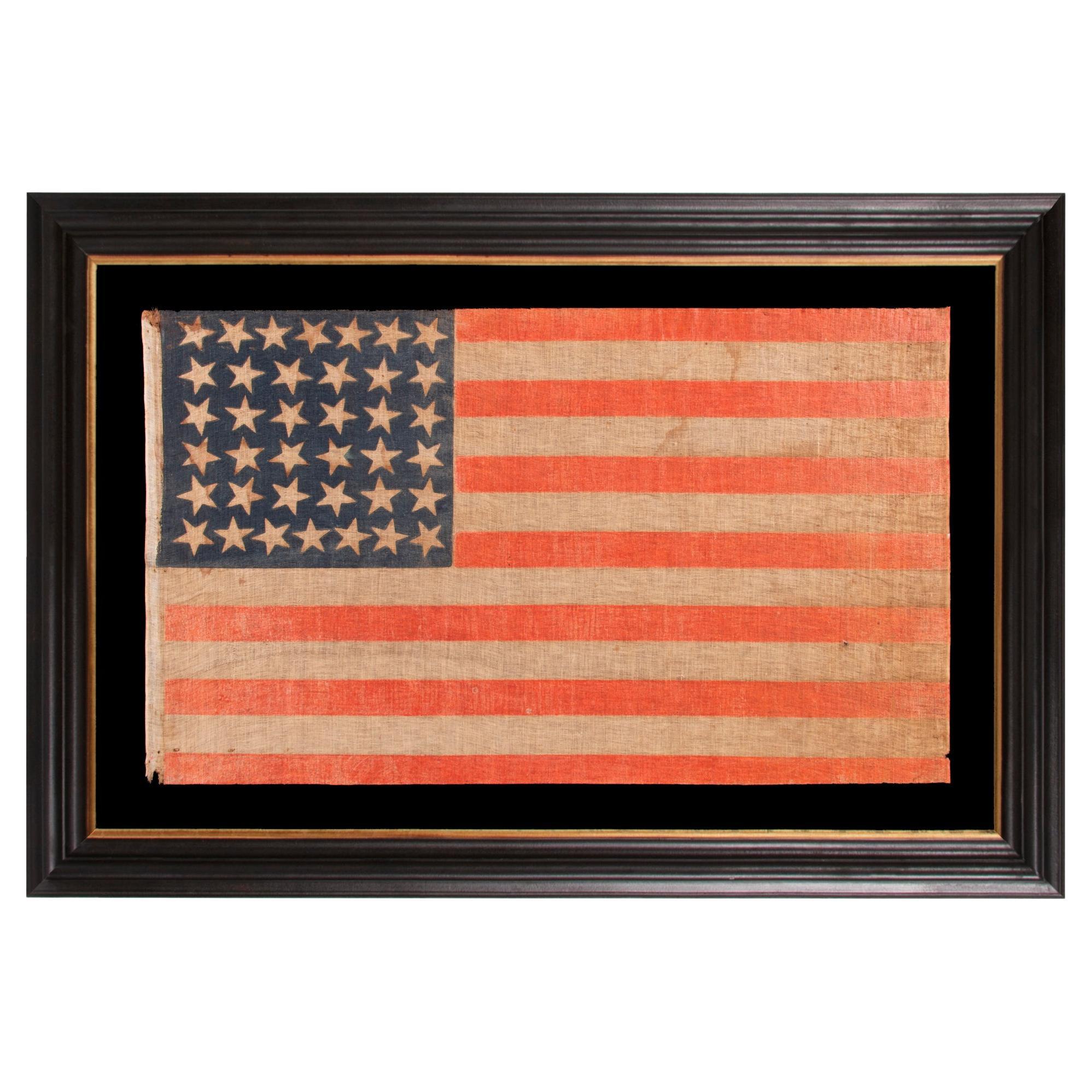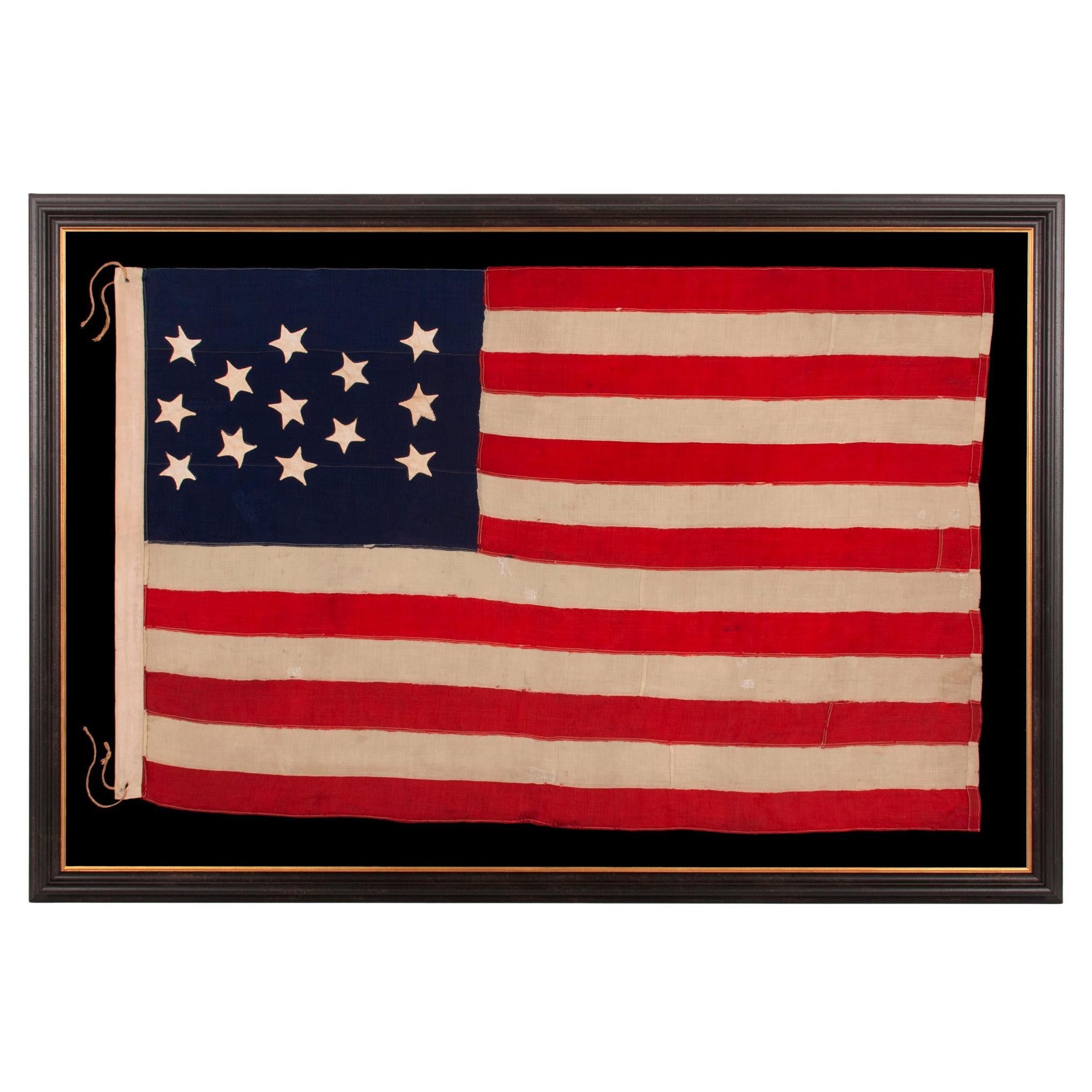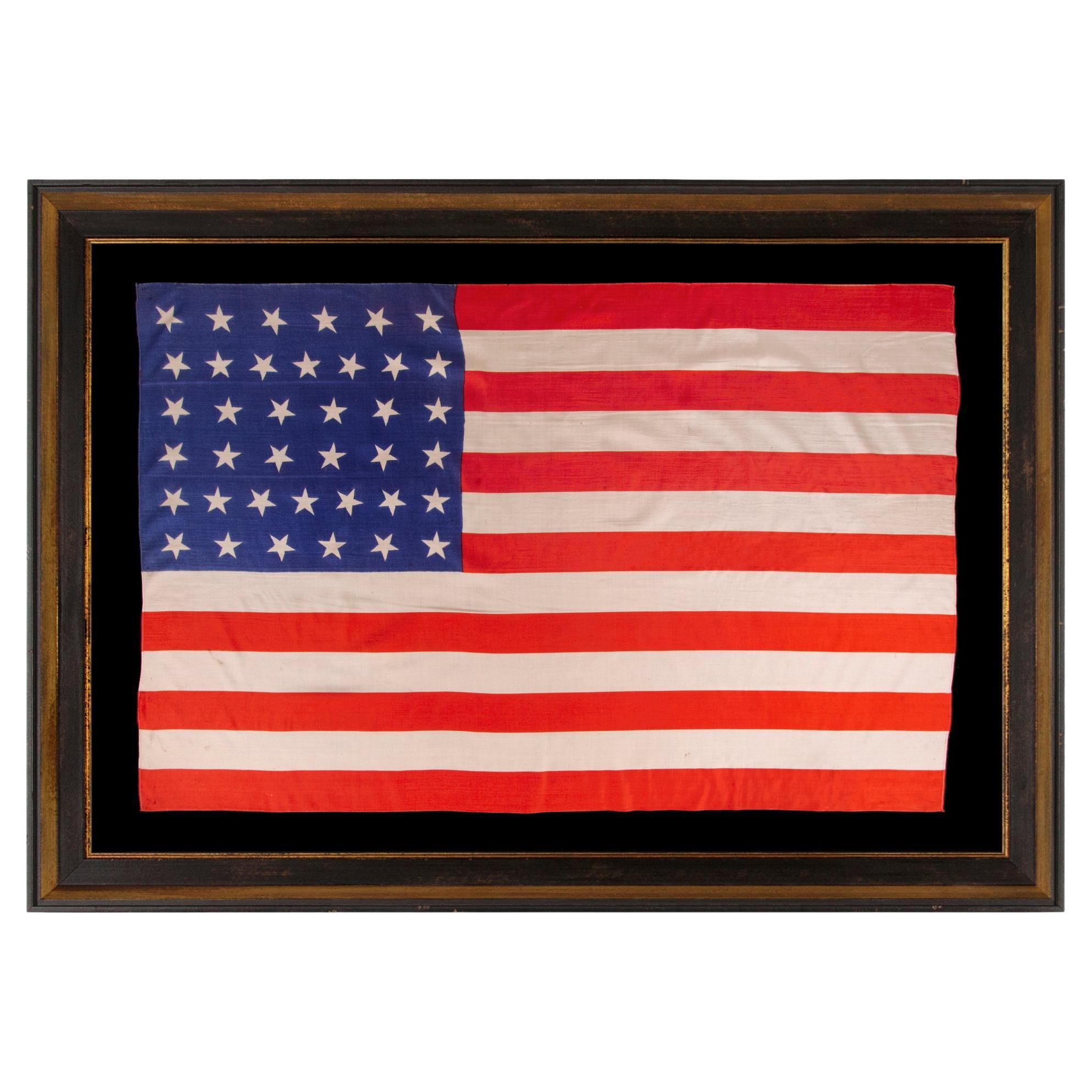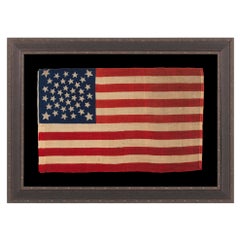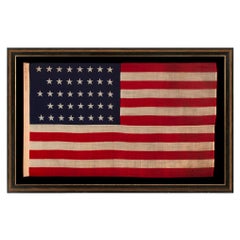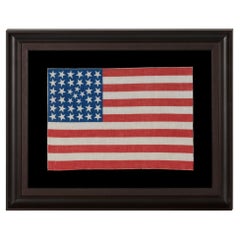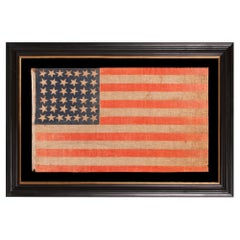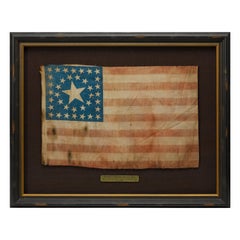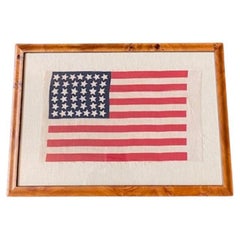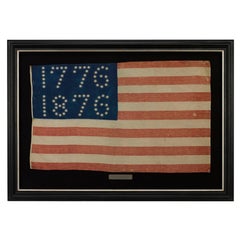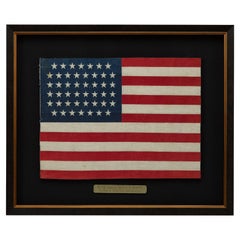Articles similaires à 38 Star Rare Circle in A Square Horstmann Brothers Made American Flag, ca 1876
Vous voulez plus d'images ou de vidéos ?
Demander au vendeur plus d'images ou de vidéos
1 sur 5
38 Star Rare Circle in A Square Horstmann Brothers Made American Flag, ca 1876
À propos de cet article
38 STARS IN A RARE AND STRIKING CIRCLE-IN-A-SQUARE MEDALLION, WITH AN ENORMOUS CENTER STAR, MADE FOR THE 1876 CENTENNIAL CELEBRATION BY HORSTMANN BROTHERS OF PHILADELPHIA, A MAJOR MILITARY OUTFITTER
38 star American national parade flag, press-dyed on wool bunting, with an especially rare type of medallion star pattern that consists of a huge center star, surrounded by a wreath of stars, with a square of stars around the perimeter. This design is significantly more rare than the equally beautiful “great star” pattern (a star made out of stars), generally thought of as the Rolls Royce of configurations among 19th century designs. Circle-in-a-square patterns are so scarce that even major collectors like Boleslaw Mastai, who wrote the first major text on flag collecting and owned more than 600 flags and flag-related objects, was evidently never fortunate enough to acquire one.
Many fantastic star patterns were made in the patriotism that accompanied or nation’s 100-year anniversary of independence in 1876 and this is among the best of all examples. Note how the vertical alignment of the stars varies greatly, but that the center star, as well as the stars in the left and right columns, all have one point directed upright. There were no regulations concerning either star configuration or position until 1912, and many flag-makers went out of their way to catch the attention of potential buyers.
The flag was made by Horstmann Brothers, a major Civil War military outfitter. I have owned examples of this precise and extremely scarce variety, on which the Horstmann name was printed. Due to the fact that the company was located in Philadelphia, and that the Centennial International Exposition—our nation's first major World’s Fair, which served as the nucleus of the national celebration—took place in the same city, in 1876, it is logical to assume that Horstmann supplied these flags to be displayed there. Photos of them, actually in use at the Expo, survive from two locations, one in a fan of flags (3 displayed) emerging from a patriotic shield, just to the left of the pavilion of Philadelphia map and print publisher Augustus Mitchell, high up on post #Q78, in the Main Building, and another from within the display of the AM District Telegraph Company (2 displayed, precise location unknown).
Note the attractive, royal blue color of the canton. Most known Horstmann examples in this rare design have much darker coloration. Sometimes there is a formal binding along the hoist of this style of flag, and sometimes not. In this case, both the hoist and fly ends are simply hemmed with treadle stitching. A series of small tack holes along the hoist, with small, associated rust stains, demonstrates how it was affixed to a wooden staff, with metal tacks.
Press-dyed wool flags are scarcer than those printed on cotton and silk. Because parade flags were often intended for one day's use at a parade, political rally, a reunion of soldiers, or some other patriotic event, most were made of cotton. While cotton absorbs water, short-term use precluded the need for anything more hardy. Because the Centennial Exposition lasted for a period of six months, it required decorative flags that would sustain being flown for a longer time and withstand the elements. Because wool sheds water, it was the fabric of choice selected by flag-makers for extended outdoor use. Prior to this time, press-dyed wool flags primarily served military function. With the advent of lengthy World’s Fair events in America, they were well-suited for the long-term, decorative applications these required and adapted as such.
Colorado became the 38th state on August 1st, 1876. This was the year of our nation’s 100-year anniversary of independence. Per the Third Flag Act of 1818, stars were not officially added until the 4th of July following a state's addition. For this reason, 37 was the official star count for the American flag in 1876. Flag-making was a competitive venture, however, and few flag-makers would have continued to produce 37 star flags when their competitors were making 38’s. It is for this reason that 38 and 13 stars (to represent the original 13 colonies) are more often seen at the Centennial Expo.
Some flag-makers would have been adding a star for the 38th state even before it entered the Union, in the early part of 1876 or even prior. In fact, many makers of parade flags were actually producing 39 star flags, in hopeful anticipation of the addition of two more Western Territories instead of one. But the 39th state would not join the Union for another 13 years, when the Dakota Territory entered as two states on the same day. The 38 star flag became official on July 4th, 1877 and was generally used until the addition of the Dakotas in 1889.
A Brief History of the Horstmann Company:
William H. Horstmann (1785-1850) was the founder of what would become a major military outfitter in both Philadelphia and New York City. A solider and fourth generation passementier (textile weaver), Horstmann emigrated to the United States from Cassel, Germany in either 1815 or 1816, settling in the Germantown area of Philadelphia, where there was a significant concentration of textile manufacturing. Horstmann established a business of manufacturing fringe, laces, and trimmings at 50 N. Third St. and soon after married the daughter of Frederick Hoeckly, the most successful lace manufacturer in the city. In 1824 he introduced three significant tools to America, including the first jacquard loom, for weaving multicolored fabrics, the first braiding machine, and a machine for plating metal. Moving to the corner of 59th & Third, he imported technology from Germany and elsewhere and maintained regular trade with his family in Europe. The company grew exponentially in size and had many addresses over its years of operation
In 1828, the William H. Horstmann Military Store opened and in 1831 he established a New York branch. In 1843 the name was changed to the William H. Horstmann & Sons Military Store, and in 1859 it was taken over by sons Sigmund H. and William J., who operated the business as Horstmann Bros. & Co. in both New York and Philadelphia. Taking on investors in the interim, from 1845-1849 it operated in NYC as Horstmann Sons & Drucker, then Horstmann Sons & Allien. As an outfitter of Civil War regiments, the firm manufactured its own goods, including flags, swords, drums, insignia, and many other items, and subcontracted for the manufacture of these objects as well, depending on financial sensibility. There were other investors and partners along the way, such as William S. Hassall and George Evans, who broke off and became a significant competitor as “Hassall & Evans.” Brothers Sigmund & William Horstmann passed in 1870 and 1872, respectively.
In 1877, the New York branch changed its name to that of partner H.V. Allien. In 1893 the Philadelphia location changed its name to simply “Wm. H. Horstmann Co.,” operating as such until 1940. In 1927 “Horstmann Uniform Co.” was established as a separate entity, though it operated in a building within the large, Horstmann campus. In 1948, both the Philadelphia and New York branches filed for bankruptcy and closed.
Mounting: The flag was mounted and framed within our own conservation department, which is led by expert trained staff. We take great care in the mounting and preservation of flags and have framed thousands of examples.
The background is 100% cotton twill, black in color, that has been washed and treated for colorfastness. The mount was placed in a gilded molding of exceptional quality, with a traditional, American profile, to which a step-down profile, shadowbox depth molding, with a very dark brown finish, almost black, with reddish undertones and highlights, was added as a cap. The glazing is U.V. protective acrylic (Plexiglas). Feel free to contact us for more details.
Condition: In addition to the aforementioned tack holes and associated rust stains along the hoist, there is a tiny moth hole in the canton and a few in the striped field, accompanied by a couple of extremely minor stains. Overall exceptional for a wool flag of the period, with extremely strong color.
Frame Size (H x L): 30" x 39.75"
Flag Size (H x L): 19" x 28.75"
À propos du vendeur
5,0
Vendeur reconnu
Ces vendeurs prestigieux sont des leaders du secteur. Ils représentent le summum en matière de qualité et de design.
Établi en 1991
Vendeur 1stDibs depuis 2008
69 ventes sur 1stDibs
Temps de réponse habituel : Un à deux jours
- ExpéditionRecherche du devis...Expédition depuis : York County, PA
- Politique des retours
Certaines parties de cette page ont été traduites automatiquement. 1stDibs ne garantit pas l'exactitude des traductions. L'anglais est la langue par défaut de ce site web.
Garantie d'authenticité
Bien qu'il soit peu probable que la situation se présente, dans le cas où vous rencontreriez un problème d'authenticité d'un article, contactez-nous dans un délai d'un an pour obtenir un remboursement intégral. DétailsGarantie de remboursement
Si votre article n'est pas conforme à la description, est endommagé pendant le transport ou ne vous est pas livré, contactez-nous sous 7 jours pour obtenir un remboursement intégral. DétailsAnnulation sous 24 heures
Vous disposez d'un délai de 24 heures pour annuler votre achat sans motif.Des vendeurs professionnels agréés
Nos vendeurs de renommée mondiale doivent respecter des normes strictes en matière de service et de qualité, afin de préserver l'intégrité de nos fiches produit.Garantie d'alignement des prix
Si vous constatez qu'un autre vendeur a mis en vente le même article à un prix inférieur sur un autre site, nous nous alignerons sur ce prix.Livraison en toute confiance à l'international
Notre réseau de transporteurs de premier ordre propose des options d'expédition spécialisées dans le monde entier, y compris des livraisons personnalisées.Plus d'articles de ce vendeur
Tout afficherDrapeau américain à 38 étoiles, État du Colorado, fabriqué par les frères Horstmann vers 1876
38 ÉTOILES, COLORADO STATEHOOD, UN RARE ET MAGNIFIQUE DRAPEAU AMÉRICAIN ANCIEN AVEC UN MOTIF DE MÉDAILLON ET 4 GRANDES ÉTOILES D'ANGLE, TEINT À LA PRESSE SUR UN BUNTING EN LAINE, FAB...
Catégorie
Antiquités, Fin du XIXe siècle, Américain, Objets à caractère politique ...
Matériaux
Laine
Drapeau américain ancien à 38 étoiles, État du Colorado, fabriqué dans le Massachusetts 1876-89
38 STAR ANTIQUE AMERICAN FLAG WITH A NOTCHED CONFIGURATION, MADE BY THE U.S. BUNTING COMPANY IN LOWELL, MASSACHUSETTS, REFLECTTS THE ERA OF COLORADO STATEHOOD, circa 1876-1889
Drape...
Catégorie
Antiquités, Fin du XIXe siècle, Américain, Objets à caractère politique ...
Matériaux
Laine
Drapeau de parade américain ancien à 38 étoiles, État du Colorado, vers 1876-1889
38 ÉTOILES DANS UNE CONFIGURATION EXTRÊMEMENT INHABITUELLE QUI PORTE UN GROUPE DE 6 PETITES ÉTOILES DANS UN MOTIF LINÉAIRE D'ÉTOILES PLUS GRANDES, 1876-1889, CRÉATION DE L'ÉTAT DU CO...
Catégorie
Antiquités, Fin du XIXe siècle, Américain, Objets à caractère politique ...
Matériaux
Coton
Drapeau de parade américain ancien à 38 étoiles, État du Colorado, vers 1876-1889
DRAPEAU DE PARADE AMÉRICAIN ANTIQUE À 38 ÉTOILES, AVEC DES RANGÉES JUSTIFIÉES DE 7-6-6-6-6-7 ET DES ÉTOILES DISPERSÉES, FABRIQUÉ PENDANT LA PÉRIODE OÙ LE COLORADO ÉTAIT L'ÉTAT LE PLU...
Catégorie
Antiquités, Fin du XIXe siècle, Américain, Objets à caractère politique ...
Matériaux
Coton
Drapeau américain ancien à 13 étoiles avec une présentation étroite d'étoiles, vers 1876
DRAPEAU AMÉRICAIN ANTIQUE À 13 ÉTOILES AVEC DES ÉTOILES COUSUES À LA MAIN DANS UNE PRÉSENTATION EXTRÊMEMENT ÉTROITE D'UNE DISPOSITION 3-2-3-2-3 SUR UN CANTON QUI NE SUIT PAS, LAISSAN...
Catégorie
Antiquités, années 1870, Américain, Objets à caractère politique ou patr...
Matériaux
Laine
Drapeau américain ancien à 38 étoiles, État du Colorado, vers 1876-1889
Drapeau de parade américain antique à 38 étoiles dispersées, en soie, avec une échelle généreuse et des couleurs vives, État du Colorado, 1876-1889
Drapeau de parade national amér...
Catégorie
Antiquités, Fin du XIXe siècle, Américain, Objets à caractère politique ...
Matériaux
Soie
Suggestions
Drapeau américain ancien à 38 étoiles avec canton unique, vers 1876-1890
Il s'agit d'un remarquable drapeau américain à 38 étoiles. Le drapeau date de 1876-1890, lorsque le Colorado (représenté par la grande étoile au centre du canton du drapeau) a rejoin...
Catégorie
Antiquités, Fin du XIXe siècle, Américain, Objets à caractère politique ...
Matériaux
Mousseline
Drapeau de parade américain à 38 étoiles, vers 1877
Ancien drapeau de parade américain à 38 étoiles, vers 1877, un petit drapeau de parade en lin finement tissé avec 38 étoiles dans un motif audacieux "Dancing Star", promulgué en 1877...
Catégorie
Antiquités, années 1870, Américain, Fédéral, Objets à caractère politiqu...
Matériaux
Lin
Banner du drapeau américain du centenaire « 1776-1876 »
Voici une rare bannière patriotique du Centenaire, datant de 1876. Le canton bleu brillant du drapeau est spectaculaire, avec 81 étoiles rayonnantes à cinq branches, disposées de man...
Catégorie
Antiquités, années 1870, Américain, Objets à caractère politique ou patr...
Matériaux
Laine, Coton
Drapeau américain à 46 étoiles imprimé dans une configuration d'étoiles de tambour
Il s'agit d'un drapeau de parade américain original à 46 étoiles, célébrant l'accession de l'Oklahoma au rang d'État. Chaque étoile du canton du drapeau représente un État de l'Union...
Catégorie
Vintage, Années 1910, Américain, Objets à caractère politique ou patriot...
Matériaux
Soie
Drapeau de parade américain à 38 étoiles flottant lors d'une réception pour le président Grant, 1880
Il s'agit d'un drapeau de parade américain à 38 étoiles magnifiquement coloré, déployé lors d'une réception publique en l'honneur d'Ulysses S. Grant en octobre 1880. Ce drapeau impri...
Catégorie
Antiquités, années 1880, Américain, Objets à caractère politique ou patr...
Matériaux
Coton
Drapeau américain ancien à 39 étoiles avec motif d'étoiles « fantaisistes », 1889
Il s'agit d'un drapeau américain non officiel à 39 étoiles, fait à la main et imprimé sur du coton. Le drapeau date de 1889 et a une histoire unique, grâce à son nombre rare d'étoile...
Catégorie
Antiquités, années 1880, Américain, Objets à caractère politique ou patr...
Matériaux
Coton
